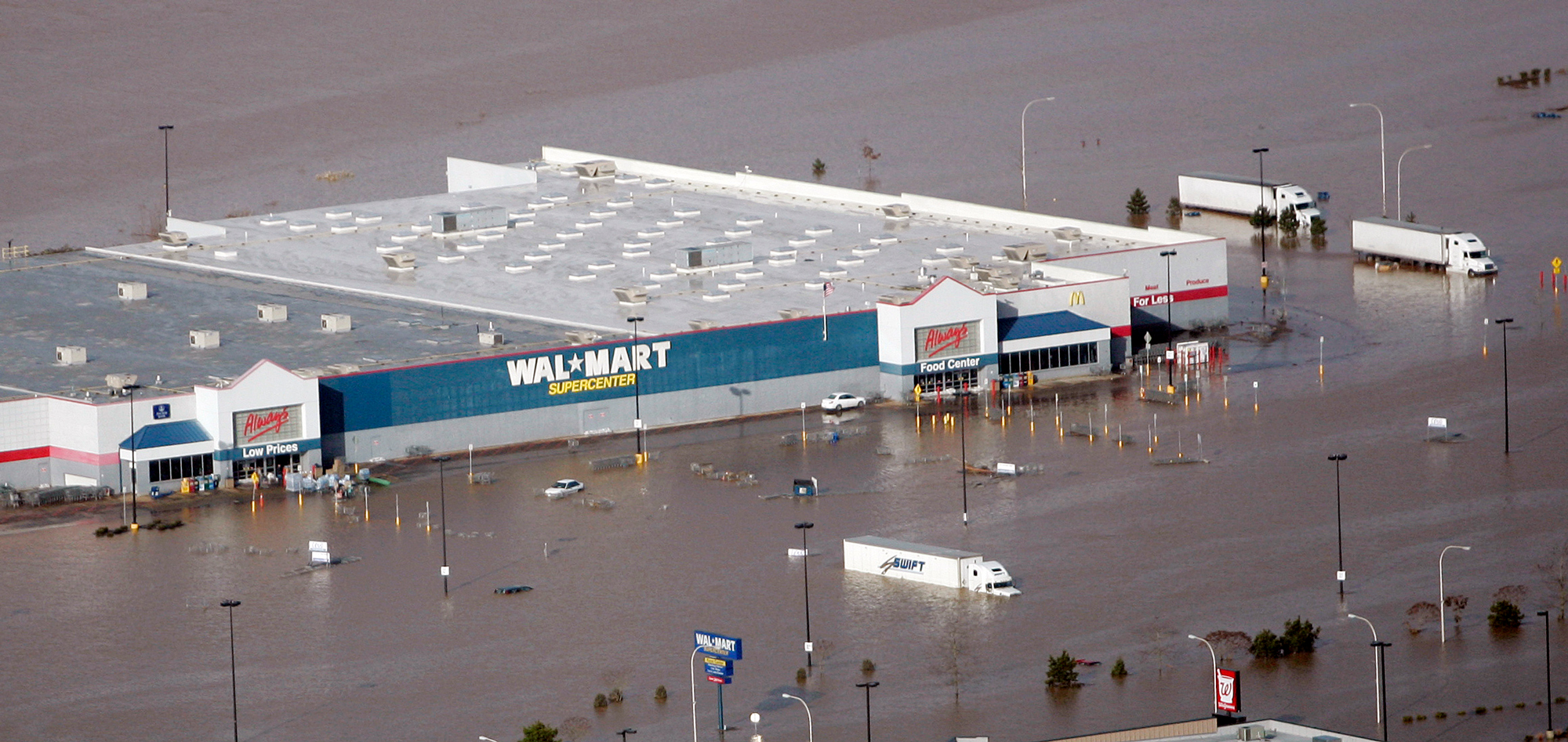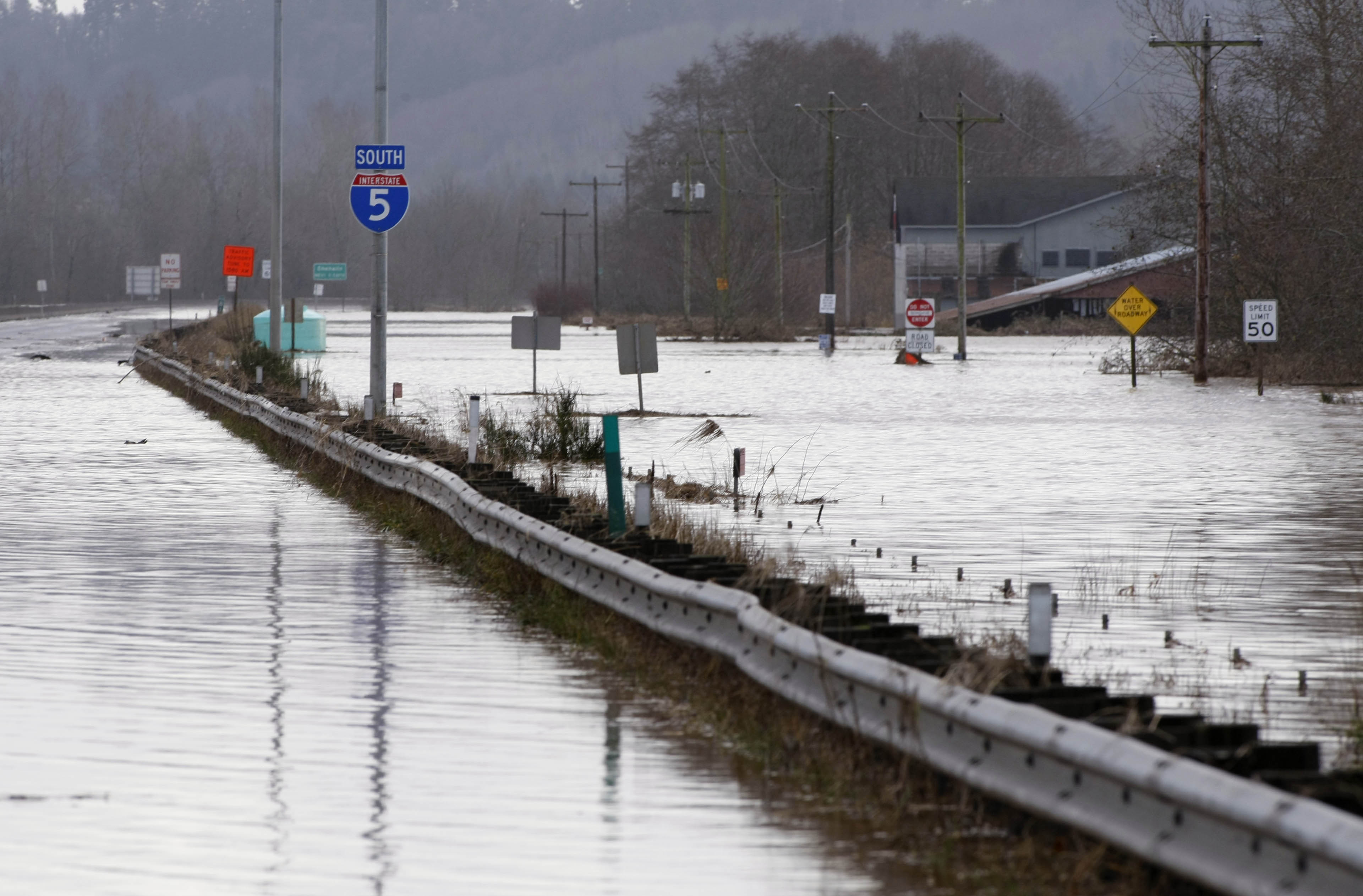Benefits
The flow-through dam for flood control is one part of the Chehalis Basin Strategy to make the Chehalis Basin a safe, healthy, and plentiful place to live—for people, fish, and wildlife.
Flood Risk Reduction
The flow-through dam for flood control will significantly reduce the damage from major and catastrophic floods, a benefit that will only increase over time.
Flooding is a natural process central to the Chehalis Basin that provides benefits to the ecosystem. While the flow-through dam will not end all flooding, it will help protect the Chehalis community from increasingly severe and frequent floods.
The Chehalis Basin is already experiencing more frequent and intense flooding because of climate change17 18, with the largest floods on record all occurring within the past 30 years.19 Washington State and the people of the Chehalis Basin are at a crucial decision point to determine the best method for flood risk reduction.

Floodwaters reached record highs in 2007

Walmart inundated during 2007 flood
For near-term future floods like those experienced in 1996 and 2007, the flow-through dam would eliminate flooding for 1,135 structures, reduce flood damage by an estimated 72%, protect 1,700 people from displacement, and prevent about $240 million in damage.20
The graphics below depict the impact of flooding in a mid-century catastrophic flood without the flow-through dam compared to the impact with the flow-through dam.
Mid-Century Catastrophic Flood Event
Structures Inundated vs Protected During Mid-Century
Without Flow-Through Dam
100 structures flooded
Protected with Flow-Through Dam
1,135 structures protected from flooding
100 structures protected from flooding
Damage Costs During Mid-Century Catastrophic Flood Event
Cost of damage without flow-through dam
$336
million
Cost of damage with flow-through dam
$95 million
Over $241 million in damage avoided
Climate Resilience
Climate change models project that flood risk in the Chehalis Basin will continue increasing because of warmer temperatures, snowmelt, and storms21. Along with flooding, climate change will likely contribute to increased river temperatures in the Chehalis Basin, making it difficult or impossible for many aquatic species to survive.22
Floods like those in 1996 and 2007 are likely to occur more often and cause substantial damage.23 By late-century (~2080), floods will likely inundate around 3,000 buildings24, displacing an estimated 7,000 people
Without the flow-through dam, a late-century catastrophic flood could cause the impacts shown below:26
In this late-century scenario, the flow-through dam would prevent the inundation of about 3,514 acres during a major flood and 3,795 acres during a catastrophic flood.27
Models estimate that, for floods occurring at the end of the century, the flow-through dam would eliminate flooding for about 1,28028 structures, prevent the displacement of 1,800 people29, and avoid about $330 million in damage each time a flood occurs.30
The graphics below depict the impact of flooding in a late-century catastrophic flood without the flow-through dam compared to the impact with the flow-through dam.
Late-Century Catastrophic Flood Event
Structures Inundated vs Protected During Late-Century
Without Flow-Through Dam

100 structures flooded
Protected with Flow-Through Dam

1,280 structures protected from flooding
100 structures protected from flooding
Damage Costs During Late-Century Catastrophic Flood Event
Cost of damage without flow-through dam
$669
million
Cost of damage with flow-through dam
$339
million
Over $330 million in damage avoided
The need for the flow-through dam will only increase with time.31
In 2007, approximately 1,500 homes and businesses were damaged by flooding. In the future, this is likely to double, with nearly 3,000 or more structures impacted by flooding.
Volitional Fish Passage
The flow-through design allows for volitional fish passage, meaning that fish, sediment, and debris less than 2 feet wide can freely move upstream and downstream. This allows fish to find food, hide from predators, and rest on their own, which preserves natural fish migration routes, minimizes the disruption of ecosystem processes, and maintains the river’s natural dynamics.

Traditional
The dam blocks the movement of water, fish, and sediment

Flow-through Dam
Water, fish and sediment can move through the dam unobstructed
Mitigation Efforts
The flow-through dam will be accompanied by a Revised Mitigation Plan to help avoid warming river temperatures and support a healthy ecosystem throughout the Chehalis Basin. The goal of the Revised Mitigation Plan is to offset impacts and improve habitat function, build resilience in the basin, and make it possible for fish, wildlife, and people to thrive.
More details on mitigation efforts will be available in fall 2024. Mitigation actions will be taken within the area immediately surrounding the flow-through dam as well as in other areas throughout the Basin, including:
- Implementing the Vegetation Management Plan to minimize loss of trees and vegetation that provide wildlife habitat and shade, which protects the river from increasing temperatures.
- Ensuring continued transport of sediment and woody material necessary for fish habitat.
- Expanding riparian buffers.
- Improving floodplain connectivity and adding complexity and diversity of channels.
- Enhancing wetlands across the Chehalis Basin.
- Managing invasive species.
- Additional riparian planting to increase shade in other areas of the river.
Chehalis Basin Strategy
The flow-through dam for flood control is part of the Chehalis Basin Strategy, a holistic set of actions with two primary components: reduce flood damage in the community and restore fish habitat. The facility design and plans for construction and operation aim to avoid, minimize, and mitigate the impact of the flow-through dam on fish and wildlife habitat.
The Chehalis Basin Strategy includes the Aquatic Species Restoration Plan (ASRP), flood preparation assistance for residents and business owners, technical assistance for tribes and local governments, and analysis of other options for flood protection, including the flow-through dam. More detail is available at chehalisbasinstrategy.com.
17 State Environmental Policy Act Draft Environmental Impact Statement (SEPA DEIS): p. S-1, 27, 28
18 Chehalis River Basin Flood Control Zone District Comprehensive Flood Hazard Management Plan (CFHMP): p. 73, 112
19 CFHMP: p. 73
20 CFHMP: p. 135-136
21 Flood impacts - Washington State Department of Ecology
22 Chehalis Basin Long-Term Strategy: Washington State Department of Ecology
23 CFHMP: p. 99, 105
24 SEPA DEIS: p. S-9, 118
25 CFHMP: p. 98
26 CFHMP: p. 80 (for projected floodwater levels associated with images)
27 SEPA DEIS p. 117
28 SEPA DEIS p. 118
29 CFHMP p. 136
30 CFHMP p. 136
31 CFHMP: p. 64, 84, 99

